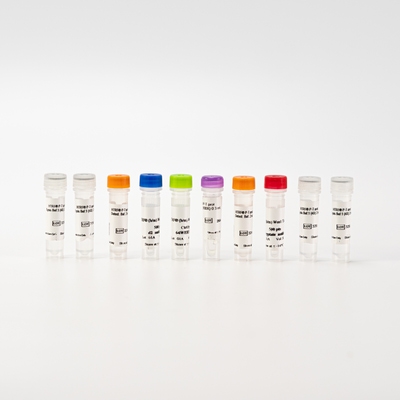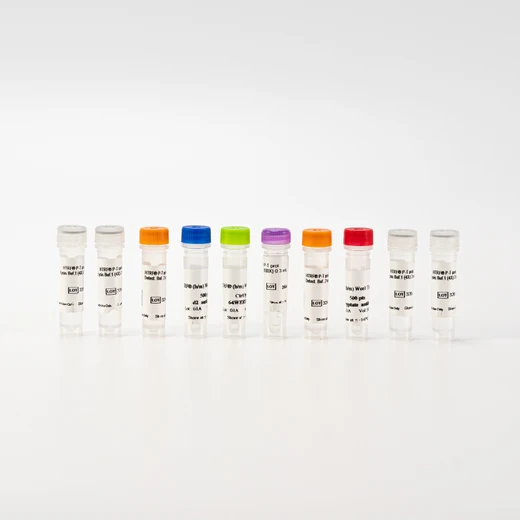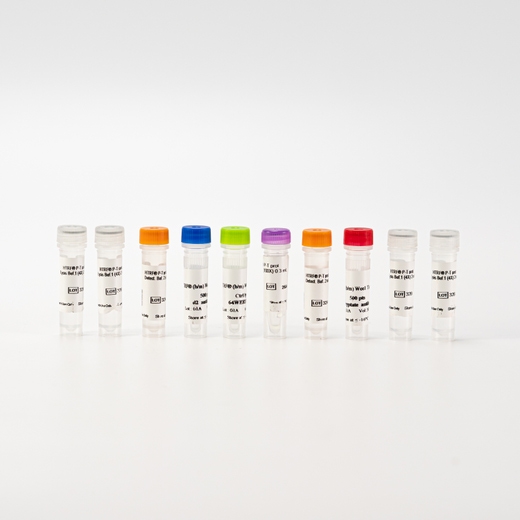

HTRF Human & Mouse Total Wee1 Detection Kit, 10,000 Assay Points


HTRF Human & Mouse Total Wee1 Detection Kit, 10,000 Assay Points






The Total Wee1 kit is designed to monitor the expression level of cellular Wee1, a serine/threonine kinase.
For research use only. Not for use in diagnostic procedures. All products to be used in accordance with applicable laws and regulations including without limitation, consumption and disposal requirements under European REACH regulations (EC 1907/2006).
| Feature | Specification |
|---|---|
| Application | Cell Signaling |
| Sample Volume | 16 µL |
The Total Wee1 kit is designed to monitor the expression level of cellular Wee1, a serine/threonine kinase.
For research use only. Not for use in diagnostic procedures. All products to be used in accordance with applicable laws and regulations including without limitation, consumption and disposal requirements under European REACH regulations (EC 1907/2006).



HTRF Human & Mouse Total Wee1 Detection Kit, 10,000 Assay Points



HTRF Human & Mouse Total Wee1 Detection Kit, 10,000 Assay Points



Product information
Overview
Wee1 is a serine/threonine kinase that plays an important role in regulating cell cylce. In response to DNA damage, Wee1 activity is upregulated to promote cell cycle arrest. Wee1 regulates the G2/M cell cycle checkpoint by phosphorylating and inactivating Cdk1. In the S phase, Wee1 phosphorylate Cdk2 preventing cells from entering the next cell cycle phase until DNA replication or repair is complete. Wee1 is overexpressed in many cancers, and has been correlated with poor disease-free survival for cancer patients. The inhibition of Wee1 is thus an active research area, especially since the emergence of new approaches involving PROTACs (PROteolysis TArgeting Chimeras).
Specifications
| Application |
Cell Signaling
|
|---|---|
| Brand |
HTRF
|
| Detection Modality |
HTRF
|
| Lysis Buffer Compatibility |
Lysis Buffer 1
|
| Molecular Modification |
Total
|
| Product Group |
Kit
|
| Sample Volume |
16 µL
|
| Shipping Conditions |
Shipped in Dry Ice
|
| Target Class |
Phosphoproteins
|
| Target Species |
Human
Mouse
|
| Technology |
TR-FRET
|
| Unit Size |
10,000 Assay Points
|
Video gallery

HTRF Human & Mouse Total Wee1 Detection Kit, 10,000 Assay Points

HTRF Human & Mouse Total Wee1 Detection Kit, 10,000 Assay Points

How it works
Total Wee1 assay principle
The Total WEE1 assay quantifies the expression level of WEE1 in a cell lysate. Unlike Western Blot, the assay is entirely plate-based and does not require gels, electrophoresis, or transfer. The Total WEE1 assay uses two labeled antibodies, one coupled to a donor fluorophore and the other to an acceptor. Both antibodies are highly specific for a distinct epitope on the protein. In the presence of WEE1 in a cell extract, the addition of these conjugates brings the donor fluorophore into close proximity with the acceptor and thereby generates a FRET signal. Its intensity is directly proportional to the concentration of the protein present in the sample, and provides a means of assessing the protein's expression under a no-wash assay format.

Total Wee1 two-plate assay protocol
The two-plate protocol involves culturing cells in a 96-well plate before lysis, then transferring lysates into a 384-well low volume detection plate before the addition of Total WEE1 HTRF detection reagents. This protocol enables the cells' viability and confluence to be monitored.

Total Wee1 one-plate assay protocol
Detection of Total WEE1 with HTRF reagents can be performed in a single plate used for culturing, stimulation, and lysis. No washing steps are required. This HTS designed protocol enables miniaturization while maintaining robust HTRF quality.

Assay validation
PROTAC® induced Wee1 degradation
Hek 293 cells were plated in 96-well culture plates at a density of 100,000 cells/well and incubated for 24 hours at 37°C, 5% CO2.
After cell culture medium removal, they were treated with increasing concentrations of the PROTAC compound ZNL-02-096, as well as Wee1 Inhibitor AZD-1775 used as Warehead for the PROTAC synthesis. As a control, cells were pre-incubated with a proteasome inhibitor, Epoxomicin, for 1h at 37°C prior to the addition of PROTAC.
After a 4h incubation, the cell culture medium was removed and 50 µl of supplemented Lysis Buffer#1 (1X) were dispensed into each well.
Following cell lysis, 16 µL of lysate were transferred into a 384-well low volume white microplate, and 4 µL of the HTRF Wee1 detection antibodies were added. An additional 4 µL of lysate (supplemented with 12 µL diluent #8) were also transferred into the microplate in order to monitor the alpha-tubulin level using the Alpha-tubulin Housekeeping Cellular Kit (64ATUBPET/G/H). HTRF signals for both kits were recorded after an overnight incubation.
The ZNL-02-096 PROTAC triggered a dose-dependent decrease in Wee1 protein with a DC50* of 0.41nM, while the specific Wee1 inhibitor AZD-1775 did not. The absence of any decrease in Wee1 observed in the presence of epoxomicin demonstrated a degradation driven by the ubiquitin proteasome system. In the same experimental conditions, the level oh Alpha-tubulin measured remained unchanged.
* DC50 corresponds to the concentration of the degrader at which 50% of the targeted protein is degraded.

Specificity of Total Wee1 assay using siRNA
Hek293 cells were plated in 96-well culture plates at a density of 20,000 cells/well and incubated for 24 hours at 37°C, 5% CO2. The cells were then transfected with siRNAs specific for Wee1 or Wee2, as well as with a negative control siRNA. After a 48h incubation, the cells were lyzed and 16 µL of lysates were transferred into a 384-well low volume white microplate before the addition of 4 µL of the HTRF Total Wee1 detection antibodies. HTRF signals were recorded after an overnight incubation.
Wee1 siRNA led to an 80% signal decrease compared to the cells transfected with the negative siRNA. No signal decrease was observed in cells transfected with Wee2 siRNA. In the same experimental conditions, no cytotoxic effects were observed, as evidenced by the ATP levels measured with the ATPliteTM assay.

Versatility of Total Wee1 assay using various cell lines
Adherent human cells (Hek 293, Hela, HepG2, A431 and mouse NIH3T3 cells) were plated in 96-well culture plates at a density of 100,000 cells/well. After a 24 hour incubation, cells were lyzed with 50 µl of supplemented Lysis Buffer#1 (1X), and 16 µL of lysate were transferred into a 384-well low volume white microplate before the addition of 4 µL of the HTRF Total Wee1 detection antibodies. HTRF signals were recorded after an overnight incubation.
The HTRF Total Wee1 assay efficiently detected Wee1 in various human and mouse cellular models.

HTRF Total Wee1 assay compared to Western Blot
HEK293 cells were cultured in a T175 flask in complete medium at 37°C, 5% CO2, to confluency.
After medium removal, the cells were lysed with 3 mL of supplemented lysis buffer #1 (1x) for 30 min at RT under gentle shaking.
Serial dilutions of the cell lysate were performed using supplemented lysis buffer #1 (1x), and 16µL of pure sample, and each dilution were transferred into a 384-well small volume microplate before the addition of 4µL of HTRF Total Wee1 detection antibodies. HTRF signals were recorded after an overnight incubation.
Equal amounts of lysates were loaded into a gel for a side by side comparison between HTRF and Western Blot.
In these conditions, the HTRF Total Wee1 assay is 2-fold more sensitive than the Western Blot.

Simplified pathway
Total Wee1 Signaling Pathway
Wee1 is a serine/threonine kinase-family member that plays an important role in regulating cell cycles.
To ensure the phase and synergy of cell cycle events, the activation of CDKs is particularly important. The CDK/Cyclin complex regulates the initiation and progression of various stages of the cell cycle, thereby controlling cell proliferation and apoptosis. A cell cycle arrest or delay can be induced intra S-phase, and at the transition from G1 to S and from G2 to M phase.
In response to DNA damage, Wee1 activity is upregulated to promote cell cycle arrest, preventing cells from entering the next cell cycle phase until DNA replication or repair is complete.
In the G2/M cell cycle checkpoint, Wee1 phosphorylate and inhibit Cdk1 at Tyr15. In the S phase, Wee1 phosphorylate the Tyr15 site of CDK2. The counteracting phosphatase CDC25 removes this inhibitory phosphorylation to activate CDK1 or CDK2 and promote mitotic entry. The balance of Wee1 versus CDC25 activity determines the timing of mitotic entry and cell division.
Many cancers have a deficient G1/S checkpoint, frequently via p53 mutation. Therefore, inhibition or degradation of Wee1 leads to abrogation of the G2/M checkpoint, and can sensitize a tumor to DNA-damaging strategies.

Resources
Are you looking for resources, click on the resource type to explore further.
This guide provides you an overview of HTRF applications in several therapeutic areas.


How can we help you?
We are here to answer your questions.






























